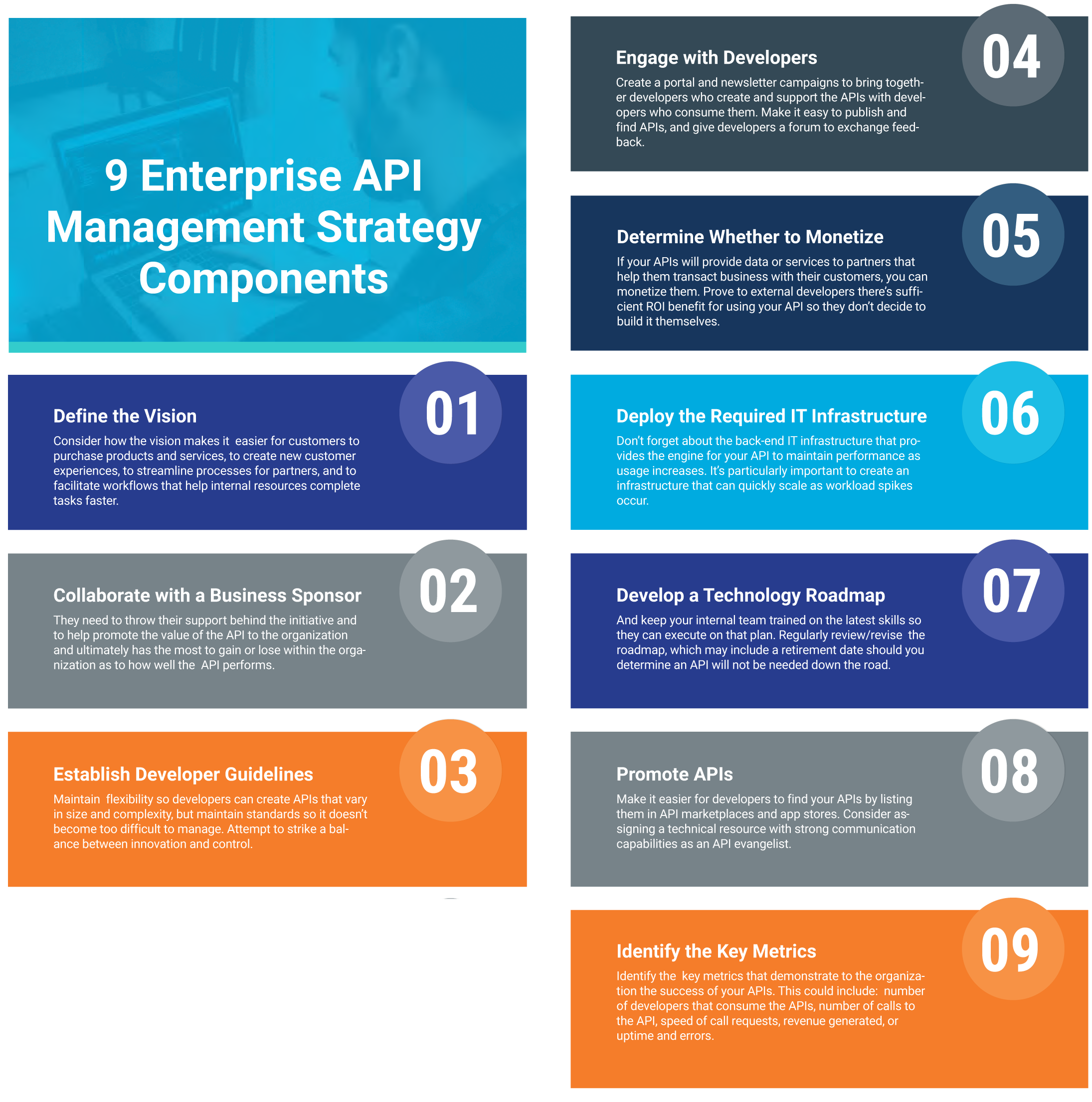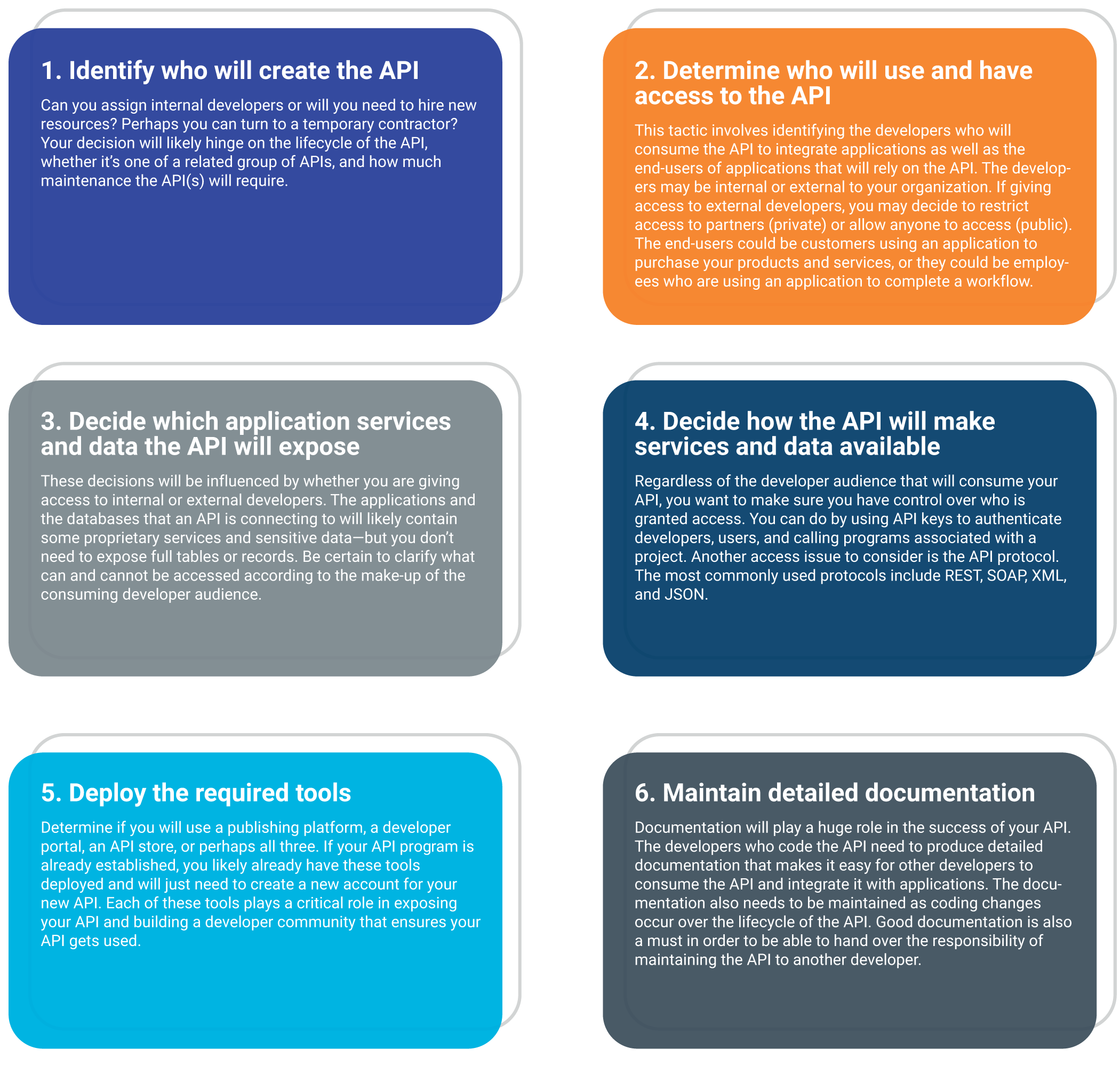
Developing an Enterprise API Strategy
Application Programming Interfaces (APIs) are just like a small business. The products need to be manufactured, marketed, sold and delivered. You also need to provide follow-up services to make sure APIs meet the needs of their users, which can include your customers, internal and external developers, and your company’s end-users. If successful, your APIs will deliver business value in the form of revenue and/or improved workflow process efficiencies.
All this makes developing an enterprise API strategy critical. Without a well-planned roadmap, your APIs will not deliver sufficient business value. They could even harm your brand reputation should customers, partners, or external developers find it difficult to consume your APIs.
9 Enterprise API Management Strategy Components
To help you take on the challenges of developing an enterprise API strategy for your business, here are 9 key planning components to consider:
#1 Define the Vision
To define the vision of your enterprise API strategy, start with what the business is looking for your APIs to accomplish:
- Make it easier for customers to purchase products and services.
- Create new customer experiences when they visit your website.
- Streamline the process for partners to transact business.
- Facilitate workflows that help internal developers complete tasks faster.
The API strategy should then proceed under the guidance of the selected business strategies. You can also base decisions on which technologies to use according to how well they fit into the API strategy.
A key factor in solidifying the vision of your API enterprise strategy is to promote the usefulness of APIs to your entire organization. Help everyone realize the key role APIs play in enabling your business to run more efficiently. This will help the internal team members who are responsible for developing, deploying, and maintaining APIs to get full support from the entire company in trying to accomplish their objectives.
#2 Collaborate with a Business Sponsor
While a technical team will design, develop, deploy, and support APIs, it’s just as important to collaborate closely with the primary business owner of each API. This person is needed to throw their support behind the initiative and to help promote the value of the API to the organization. The sponsor is also the one who ultimately has the most to gain or lose within the organization, depending upon how well the API performs. A good sponsor will help the API product manager make sure APIs get all the resources and attention they need.
#3 Establish Developer Guidelines
Programs need to remain agile and flexible so developers can create APIs that vary in their size and complexity. At the same time, you need to maintain standards so your API ecosystem does not become too difficult to manage, especially as roles change and new resources join the API team. To strike a balance between innovation and control, create methodology guidelines for API coding development, testing, security, deployment, and management. It also helps to utilize CI/CD methodologies within a DevOps culture.
#4 Engage with Developers
The success of an API program depends heavily on establishing an engaged developer community. This can be done through a portal and email/newsletter push campaigns that bring together the developers who create and support the APIs with the developers who consume the APIs. Make it easy to publish and find APIs, and give developers a forum to exchange feedback and release notes, documentation, coding information and use-cases. This sets the stage for the community as a whole to create an ecosystem that organically drives API improvements and usage.
#5 Determine Whether to Monetize
If your APIs provide data or services to partners that help them transact business with their customers, you can monetize your APIs to generate revenue. This can happen on a per transaction basis, or you can charge a flat monthly fee. As part of this effort, provide a mechanism to external developers that demonstrates why there’s a sufficient ROI benefit for using your API so they don’t decide to build the API on their own.
#6 Deploy the Required IT Infrastructure
Your API is the front-end of your offering that will hopefully wow the developers and end-users that consume them, but don’t forget about the back-end IT infrastructure that provides the engine for your API to maintain performance as usage increases. It’s particularly important to create an infrastructure that can quickly scale as workload spikes occur.
[adinserter name=”API-ebook-offer”]
#7 Develop a Technology Roadmap
As is the case with all technologies, the functionality you create for your APIs will become obsolete as supporting technologies evolve, and as your competitors come up with new ways of integrating application services. In addition to creating one, three, and five-year product roadmaps, keep your internal team trained on the latest API skills so they can make those forecasted improvements happen. Also regularly review and adjust the roadmap plan, which may include a projected retirement date should you determine an API will no longer be necessary down the road.
#8 Promote APIs
You can make it easier for developers by listing APIs in marketplaces and app stores. Also, consider assigning a technical resource with strong communication capabilities to the role of API evangelist. Someone technical will be more likely to establish rapport with the internal and/or external developer community you are targeting to consume the APIs. The evangelist should have solid blogging and social media skills and participate in developer forums to market the APIs. They should also be responsive to developer inquiries and assist in coordinating any technical support requests from developers.
#9 Identify the Key Metrics
Like any technology endeavor, it’s vital to identify the key metrics that help you measure and demonstrate to the organization the success of your APIs. In addition to the number of developers that consume the APIs and the number of calls to the API, measure the speed of call requests as well as direct and indirect revenue generation (if applicable). Other key metrics include uptime and errors generated. And while feedback comments can be a challenge to measure, find out whether developers are engaging in the developer community and using your documentation. From the end-user standpoint, it helps to survey whether they perceive that processes are working smoothly. You can also check to see how an API is impacting your Net Promoter Score.
Putting Your Enterprise API Strategy Into Action: Tactical Planning
After formulating your overall enterprise API strategy, you will delve into specific tactics each time a new API project begins. Here are some of the key issues to consider:
- Identify who will create the API
Can you assign internal developers or will you need to hire new resources? Perhaps you can turn to a temporary contractor? Your decision will likely hinge on the lifecycle of the API, whether it’s one of a related group of APIs, and how much maintenance the API(s) will require. - Determine who will use and have access to the API
This tactic involves identifying the developers who will consume the API to integrate applications as well as the end-users of applications that will rely on the API. The developers may be internal or external to your organization. If giving access to external developers, you may decide to restrict access to partners (private) or allow anyone to access (public). The end-users could be customers using an application to purchase your products and services, or they could be employees who are using an application to complete a workflow. - Decide which application services and data the API will expose
These decisions will be influenced by whether you are giving access to internal or external developers. The applications and the databases that an API is connecting to will likely contain some proprietary services and sensitive data—but you don’t need to expose full tables or records. Be certain to clarify what can and cannot be accessed according to the make-up of the consuming developer audience. - Decide how the API will make services and data available
Regardless of the developer audience that will consume your API, you want to make sure you have control over who is granted access. You can do this by using API keys to authenticate developers, users, and calling programs associated with a project. Another access issue to consider is the API protocol. The most commonly used protocols include REST, SOAP, XML, and JSON. - Deploy the required tools
Determine if you will use a publishing platform, a developer portal, an API store, or perhaps all three. If your API program is already established, you likely already have these tools deployed and will just need to create a new account for your new API. Each of these tools plays a critical role in exposing your API and building a developer community that ensures your API gets used. - Maintain detailed documentation
Documentation will play a huge role in the success of your API. The developers who code the API need to produce detailed documentation that makes it easy for other developers to consume the API and integrate it with applications. The documentation also needs to be maintained as coding changes occur over the lifecycle of the API. Good documentation is also a must in order to be able to hand over the responsibility of maintaining the API to another developer.
There’s a lot that goes into the planning process for each of these tactical areas. In addition to conducting your own research, it will help to work with a product development partner who can direct you towards API best-practices and steer you away from the pitfalls.
Setting the Stage for Long-Term API Success
A strong enterprise API strategy will enable your business to scale resources and handle heavy usage as your APIs mature and gain popularity among your developer community. Customer and partner services will become more and more reliant on your external-facing APIs, and internal APIs will play a key role in driving new business models and workflow processes that thrive on an IT infrastructure supported by more effective APIs.
The evolving and continuously improving system that your enterprise API strategy enables will also make it easier to manage your APIs and evaluate their usage and performance. This will drive a better understanding of the future requirements so the necessary improvements can be implemented to ensure the long-term success of your API program.
[adinserter name=”API-Closing”]
Recent blog posts

Stay in Touch
Keep your competitive edge – subscribe to our newsletter for updates on emerging software engineering, data and AI, and cloud technology trends.





